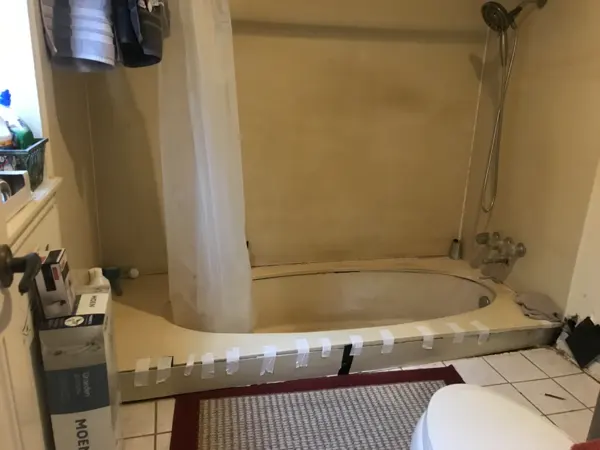Jun 16, 2025
Mold Removal in Shower
In Cleaning

Silicone is the unsung hero of a watertight bathroom—but only if you choose it (and clean it) correctly. Below is a homeowner-friendly guide to what silicone is, how it’s used in a remodel, why mold shows up on silicone and grout, and the safest ways to clean it. If you’d rather skip the headaches and get professional help planning a long-lasting, low-maintenance bath, start with a trusted local bathroom remodeling company in Houston.
What Is Silicone?
Silicone sealant is a waterproof adhesive/sealant that cures to a flexible, rubbery texture—perfect for joints that move (like shower corners and around pans, enclosures, valves, and trim). It’s often called silicone glue, mastic, caulk, silicone adhesive, silicone gel, or simply sealant.
How Is Silicone Applied?
Silicone comes in cartridges (for a caulk gun) or squeeze tubes. It’s applied in a continuous bead, tooled smooth, and then allowed to cure dry (typically 24 hours) before the shower is used. It goes on as a gel and cures to a flexible rubber that repels water and tolerates expansion/contraction.
What Is Silicone Made Of?
Silicone (the polymer) is made from silicon (the element), oxygen, carbon, and hydrogen, processed into a flexible, elastic material. Those properties make it ideal for multi-plane joints (e.g., wall-to-floor corners) where grout would crack.
Other Uses for Silicone Sealant
- Window/door frame perimeter sealing
- Kitchen/bath splash zones and plumbing penetrations
- Electrical junction moisture protection (specialized products)
- Appliance gaskets/seals (fridge/freezer), cooktop seams
Mold 101 (And Why It Likes Bathrooms)
Mold is a fungus that thrives in warm, damp, low-airflow spaces with a food source (soap residue, skin cells, dust). Bathrooms deliver all three—especially on silicone where residue can sit after showers.
Is Mold Dangerous?
Low levels are common; prolonged indoor growth can aggravate allergies, asthma, and sensitive groups (infants, elderly, immunocompromised). The solution is moisture control + routine cleaning—not panic.
Why Mold Shows Up on Silicone
Silicone and acrylic/solid surfaces are non-porous, but soap film and shampoos can leave a sticky food layer. Add steam and poor ventilation and spores bloom—especially at corners, the base, and around bottles.
Silicone vs. Grout (Where to Use Each)
How to Clean Mold on Silicone (Base/Perimeter)
Option A — Bleach Spray (fastest on white/neutral silicone):
- Gloves on. Mix 1:1 bleach and water in a spray bottle (never mix with anything else).
- Spray affected silicone; dwell ~30 minutes.
- Rinse thoroughly; wipe dry. Repeat weekly until gone, then monthly to prevent return.
Option B — Bleach Paste (for vertical joints):
- Mix bleach + baking soda to a spreadable paste.
- Brush onto silicone; cover with plastic wrap (helps it stay put).
- Dwell ~2 hours. Remove wrap, rinse well, wipe dry.
Prefer non-bleach? Hydrogen peroxide (3%) works slowly—apply, keep wet with soaked cotton pads for 30–60 minutes, then rinse. Never combine peroxide with vinegar.
Cleaning Mold on Grout
Grout is more delicate. Use a 50:50 white vinegar + water spray or paste for spot cleaning, dwell briefly, then rinse well and dry. (Do not use vinegar on natural stone like marble/limestone; use a stone-safe cleaner instead.) Avoid bleach on colored or cement grout long-term—it can weaken or discolor it.
Preventing Mold in the Bathroom
- Ventilate: Run the exhaust fan during showers and 20 minutes after; or crack a window.
- Dry surfaces: Squeegee glass/pan; wipe ledges and bottle bottoms.
- Control leaks: Fix drips, bad traps, or slow drains that leave standing water.
- Use mold-resistant paint/caulk: In high-humidity zones.
Why Silicone Beats Grout in Corners
Grout is meant for a single plane; silicone belongs at plane changes (wall-to-floor, wall-to-ceiling, tub/pan edges). It flexes, stays watertight, and insulates against drafts and heat loss around penetrations.
Safety: Never mix household chemicals. Vinegar + bleach creates toxic chlorine gas. Vinegar + hydrogen peroxide forms corrosive peracetic acid. Rinse between products and keep the room ventilated.
Need a Low-Maintenance Upgrade?
If mold keeps coming back because of failing grout or poor slope/drain sizing, consider a shower remodel with large solid-surface panels and properly sloped pans—less scrubbing, fewer seams, and better drainage.
FAQ: Silicone, Grout & Mold
Q: How long should silicone cure before I use the shower?
A: Typically 24 hours (check the tube). Keep it dry so it cures fully and bonds well.
Q: My silicone keeps getting moldy. Do I need to replace it?
A: If staining persists after proper cleaning—or the bead has gaps/peel—cut it out and re-caulk. Use bathroom-rated, mildew-resistant silicone.
Q: Can I use bleach on colored grout?
A: Not recommended long-term—it can weaken/discolor cement grout. Try vinegar (not on natural stone) or a grout-safe cleaner, then reseal if applicable.
Q: Is vinegar safe on every surface?
A: No. Avoid vinegar on natural stone (marble, limestone, travertine) and some metal finishes. Use stone-safe or manufacturer-approved cleaners instead.
Q: How often should I clean to prevent mold?
A: Quick weekly wipe-downs + good ventilation prevent most issues. Do a monthly deeper clean on silicone/grout.